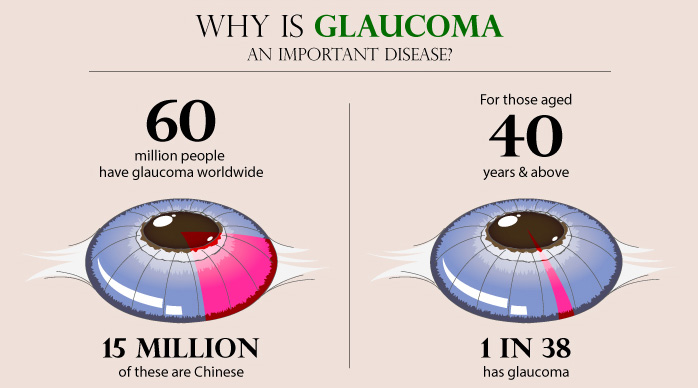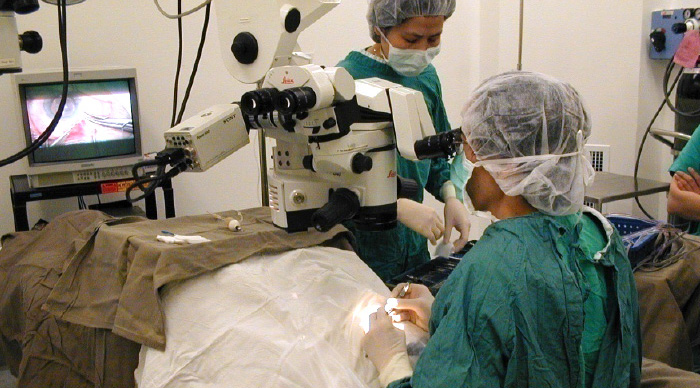Dear readers, With the launch of e-newsletter CUHK in Focus, CUHKUPDates has retired and this site will no longer be updated. To stay abreast of the University’s latest news, please go to https://focus.cuhk.edu.hk. Thank you.
Fighting Sudden Blindness on the Front Lines

Prof. Clement Tham
Department of Ophthalmology and Visual Sciences
If you have taken flu or cold medications, and it's getting late and dark in the day, and you're a long-sighted Chinese woman who is moving into your 50's or 60's, any sign of a sudden, sharp pain in your eye means you should head to the hospital, right away. You're in danger of losing your sight to acute glaucoma, and you're the exact type of person the disease is most likely to hit.
It's highly likely that an eye doctor will treat you with techniques pioneered by Prof. Clement Tham, CUHK's S. H. Ho Professor of Ophthalmology and Visual Sciences, who has been fighting glaucoma for the better part of 20 years.
The work by Professor Tham and his team has led to safer and more efficient ways of treating acute glaucoma, which strikes suddenly and with little warning, unlike the chronic form of the disease, which develops slowly over time.
Hong Kong is on the front lines of the fight against the disease. Ethnic Chinese people have a disproportionate risk of contracting acute glaucoma, as do Eskimos, at five times the rate of Caucasians. Of the 60 million glaucoma sufferers worldwide, one-quarter are Chinese. In Hong Kong alone, there are around 120,000 glaucoma victims, and one in seven of those is blind in both eyes.

Glaucoma is the biggest cause of irreversible blindness in Hong Kong, accounting for around one-quarter of all cases. Women are at particular risk of acute glaucoma, especially as they move beyond middle age. Long sightedness is another predisposition to acute glaucoma, because it means you were likely born with a shallow "anterior chamber," the front of the eye.
In acute glaucoma, the pressure inside the eyeball rises rapidly from normal levels to five times that amount within a matter of hours. If the condition isn't treated immediately, a patient can sustain permanent vision loss or even complete blindness.
The cause is a blockage in the eye that causes the iris to get stuck to the cornea at the front of the eye. In a healthy eye, there is a constant flow of aqueous fluid bringing nutrients to the tissues in the front part of the eye – neither the cornea nor the lens is served by blood vessels. The fluid pumps in from the ciliary processes that makes it, then escapes through sponge-like tissues between the iris and the cornea.
When the iris gets jammed against the cornea, what's known as angle-closure glaucoma occurs, causing a blockage that prevents the fluid from escaping. If this has happened suddenly, acute glaucoma develops and the patient will experience extreme pain and blurred vision that often causes "halos" to appear around lights.
The trigger is normally when the pupil of the eye dilates. The disease often strikes in the evening on winter days, since the oncoming darkness causes the pupil to widen, and flu medication that is often taken at that time of the year exacerbates that.
Professor Tham has helped develop a type of laser surgery that uses a laser beam to cause the iris to contract, getting the drainage angle of the eye back to its normal configuration. The process, technically known as argon laser peripheral iridoplasty, or ALPI for short, relieves the pressure and symptoms of the disease.

Traditional treatment used to require hospitalization, and the use of an intravenous drip of strong drugs over hours. With the laser surgery, a patient can leave within an hour of the process and be treated as an outpatient. It also avoids the need for the use of the drugs, which pose a threat to elderly patients since they can drop blood pressure and cause heart problems.
"It's very exciting," Professor Tham says, having demonstrated the effectiveness of the laser procedure in a series of clinical trials. "We have simplified the treatment protocol significantly." The laser surgery is now the standard first line of defense against acute glaucoma.
Professor Tham has also led the research that resulted in a better and simpler way of treating primary angle closure glaucoma, which is a very common form of glaucoma in Chinese, in the long term. To treat primary angle closure glaucoma, the conventional treatment was to conduct surgery to open up a wound in the white of the eye that allows the fluid inside it to drain away. But that creates a risk of infection, and powerful drugs normally used to treat cancer have to be applied to the surgical site to stop the body from healing the wound.
Almost half the patients treated with typical surgery developed some kind of complications later on, often because they developed cataracts that cloud the lens. Then the lenses with the cataracts have to be removed and replaced anyway.
Professor Tham led three randomized controlled clinical trials that proved that simply removing the lens of the eye and replacing it with an artificial lens made from a special form of plastic was a better option of treating this type of glaucoma and cataracts in one go. Only four per cent of primary angle closure glaucoma patients who have their lens removed develop complications.
"If we successfully used lens removal, we have avoided a lot of potential complications and a lot of suffering," Professor Tham says. "In the future, I hope we can understand a lot more about why people develop this disease and the genetic causes of it."
He also hopes that modern medicine can uncover a way to eventually undo the damage done by glaucoma. "The biggest challenge is to reverse the vision loss caused by glaucoma, possibly through stem cell research in the coming decade" Professor Tham says. "The best we can do now is freeze the disease."
By Alex Frew McMillan
This article was originally published on CUHK Homepage in Feb 2014.